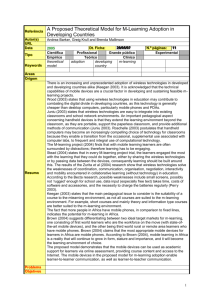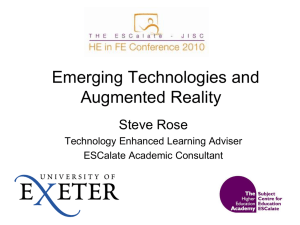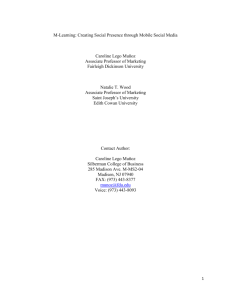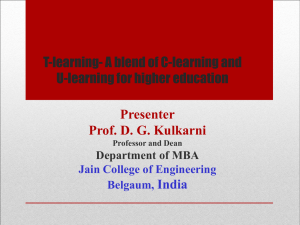Chapter 9.4
advertisement
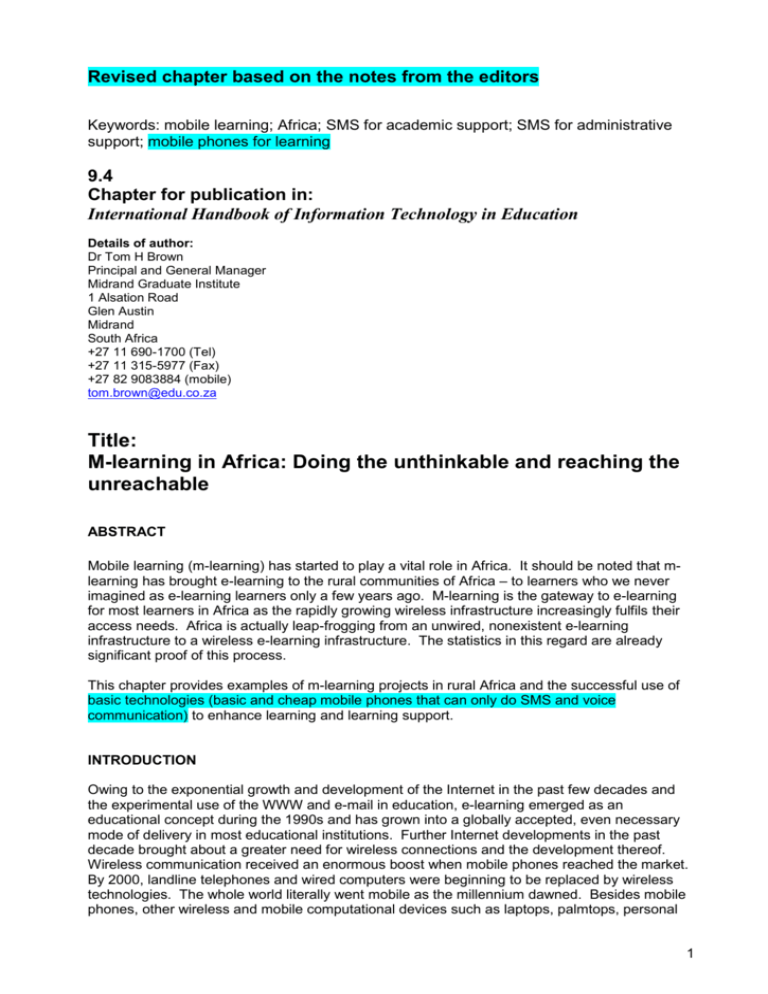
Revised chapter based on the notes from the editors Keywords: mobile learning; Africa; SMS for academic support; SMS for administrative support; mobile phones for learning 9.4 Chapter for publication in: International Handbook of Information Technology in Education Details of author: Dr Tom H Brown Principal and General Manager Midrand Graduate Institute 1 Alsation Road Glen Austin Midrand South Africa +27 11 690-1700 (Tel) +27 11 315-5977 (Fax) +27 82 9083884 (mobile) tom.brown@edu.co.za Title: M-learning in Africa: Doing the unthinkable and reaching the unreachable ABSTRACT Mobile learning (m-learning) has started to play a vital role in Africa. It should be noted that mlearning has brought e-learning to the rural communities of Africa – to learners who we never imagined as e-learning learners only a few years ago. M-learning is the gateway to e-learning for most learners in Africa as the rapidly growing wireless infrastructure increasingly fulfils their access needs. Africa is actually leap-frogging from an unwired, nonexistent e-learning infrastructure to a wireless e-learning infrastructure. The statistics in this regard are already significant proof of this process. This chapter provides examples of m-learning projects in rural Africa and the successful use of basic technologies (basic and cheap mobile phones that can only do SMS and voice communication) to enhance learning and learning support. INTRODUCTION Owing to the exponential growth and development of the Internet in the past few decades and the experimental use of the WWW and e-mail in education, e-learning emerged as an educational concept during the 1990s and has grown into a globally accepted, even necessary mode of delivery in most educational institutions. Further Internet developments in the past decade brought about a greater need for wireless connections and the development thereof. Wireless communication received an enormous boost when mobile phones reached the market. By 2000, landline telephones and wired computers were beginning to be replaced by wireless technologies. The whole world literally went mobile as the millennium dawned. Besides mobile phones, other wireless and mobile computational devices such as laptops, palmtops, personal 1 digitial assistants (PDA) and tablets also rapidly entered the market – some devices, of course, with more success than others for particular markets. In the past decade we have become familiar with the term e-learning and now m-learning is emerging. The following comprehensive definition of Urdan and Weggen (2000) provides an adequate basis for distinguishing between m-learning and e-learning: The term e-learning covers a wide set of applications and processes, including computerbased learning, Web-based learning, virtual classrooms and digital collaboration. We define e-learning as the delivery of content [and interaction] via all electronic media, including the Internet, intranets, extranets, satellite broadcast, audio/video tape, interactive TV, and CD-ROM. Yet, e-learning is defined more narrowly than distance learning, which would include text-based learning and courses conducted via written correspondence. (p.8) M-learning is a subset of e-learning. E-learning is the macro concept that includes online and mobile learning environments. The following simple definition of Quin (2001) helps to explain this: “M-learning is e-learning through mobile [and handheld] computational devices” (p.1). [Author’s addition between square brackets]. M-learning is a natural extension of e-learning and has the potential to make learning even more widely available and accessible than we are used to in existing e-learning environments. The role that communication and interaction plays in the learning process is a critical success factor. It is in this context that m-learning can contribute to the quality of education. It offers opportunities for the optimisation of interaction between lecturers and learners, among learners and among members of Communities of Practice (COP). WHY M-LEARNING IN AFRICA One’s first impressions and perceptions when thinking about the ideal target market for mlearning would probably be something like a First World learner population who are already highly ICT literate, use the latest handheld device and are either in full-time employment or merely prefer studying at their own pace, place and time. However, this description does not fit the majority of learners in Africa. Why then m-learning in Africa? Well, the answer is quite interesting. Because of the lack of fixed-line infrastructure for ICT (cabling for Internet and telecom) in certain areas in Africa, the growth of wireless infrastructure is enormous --- even more rapid than in many First World countries. The East African ( 2002) reported : “… the communications sector in Uganda is growing rapidly. Nua Internet Surveys (July 15, 2002) reported that, according to the National Information and Communication Technology Policy, the number of mobile phone subscribers in Uganda grew from 3,500 in 1996 to a total of 360,000 in 2002.” Wachira (2003:1) reported the following about Kenya: “When Vodafone UK sent Michael Joseph to Kenya in July 2000 to set up Safaricom, a cell-phone service operator jointly owned by Telkom Kenya, he did not expect the subscriber base to grow beyond 50,000 connections. Today, both Safaricom and rival KenCell Communications (partly owned by Vivendi) have nearly 1.3 million cell-phone subscribers. This set-up is deeply rooted in the traditional African communal mode of living, which many urban dwellers haven’t abandoned”. (p.1) Shapshak (2002) reported that the adoption rate of mobile technologies in Africa’s developing countries is among the highest rates globally and forecasts estimate almost 100 million mobile users in Africa by 2005. Between 1997 and 2001, the number of mobile phone subscribers in Africa annually had a triple-digit growth rate. The number of mobile subscribers in Africa rose 2 further and increased by over 1 000% between 1998 and 2003 to reach 51,8 million (International Telecommunication Union, 2004). It is thus obvious that the adoption rate of mobile technologies is exceptional in Africa. Also evident is the fact that Africa is actually leap-frogging from an unwired, nonexistent e-learning infrastructure to a wireless e-learning infrastructure. According to Brown (2004), we can therefore differentiate between two ideal target markets for m-learning: learners who are either without infrastructure and access or learners who are continually on the move. In other words: First World learners who are the workforce on the move with state-of-the-art mobile devices. Third World rural or remote area learners with mobile phones. OVERVIEW OF CURRENT M-LEARNING ACTIVITIES IN AFRICA In some African countries there are many projects and in others m-learning is still nonexistent. The majority of projects outside of South Africa, but still in Sub-Saharan Africa, are funded and supported by European and U.S. agencies. In Kenya, for example, there are several European Union funded projects with onsite support from personnel from various European countries. The summary below provides an overview of activities across the African continent. Mobile phones are used for the following purposes: Administrative learning support: o Administrative information. o Access to examination and test marks via a mobile service number or m-portal. o Access to financial statements. o Registration data via mobile service number or m-portal. Academic learning support: o Communication and interaction (bulk Short message Service (SMS) and Interactice Voirce Response (IVR). o Assessment (Multiple choice questions/ quizzes). o Feedback on assignments and tasks. o Motivational and instructional messages. The use of PDAs, Smartphones and pocket PCs for: Classroom “tools” for note taking, scheduling, etc. Beaming (via Bluetooth) in classrooms to share notes, hand in assignments, etc. Assessment: assessing performance and providing automated results and feedback. Coursework, scheduling and assignments in wireless environments; language learning through SMS. Just-in-time and on-the-spot information for field workers and field studies. Experiential learning and fieldwork. Personalised learning (appreciation for individual and learner-specific learning process). Mobile composing (music composition on PDAs). Contextual and local awareness (e.g. at museums). Mobile tutoring. Mobile blogging (moblogging - blogging on mobile devices). Courseware and multimedia on PDAs, including distribution and streaming. Human language technologies (HLT) (speech-to-text; voice recognition). Collaborative activities via multi-user applications. Collaborative learning and discussion groups. The integration of m-learning with established e-learning environments: 3 M-portals and SMS-gateways: o SMS-portal integrated with Learning Management Systems (LMS) or Learning Content Management Systems (LCMS), e.g. WebCT. o Mobile tutoring. o Moblogging. o M-assessment (e-assessment on mobile devices). o Collaborative learning and discussion groups. Wireless environments: o Pilot wireless classrooms. o Hot spots and wireless LANs on campus. EXAMPLES OF M-LEARNING IN AFRICA To provide more specific examples of some of the m-learning projects and activities in Africa, it would be appropriate at this stage, to share the following examples at the University of Pretoria in South Africa. Examples of projects with PDAs At the University of Pretoria, two projects have been launched using personal digital assistants (PDAs). In the first project (from 2004 to 2005), an M-learning project in the Faculty of Health Sciences, PDAs were used in the clinical assessment sessions of medical students. Performance was assessed and automated results and feedback provided. The project leader is Prof Ina Treadwell of the Faculty’s Skills Laboratory. Project software was funded by HaPerT software in Vienna, Austria. Research is being done on the impact of PDA use on assessment quality; the impact of PDA use on student performance; and the impact on efficiency and effectiveness (impact on administrative load, time, paper work, human errors, calculation errors, record keeping, duplication, costs, etc). Since the project is still in progress, no official results are as yet available. However, the feedback received thus far is extremely positive regarding efficiency, effectiveness and cost savings. In the second project (from 2004 to 2006), an M-learning project in the Faculty of Engineering, Built Environment and Information Technology, students in a fourth-year course have been issued with PDAs to use in a pilot wireless e-learning environment. PDAs are used for queries, content delivery, interactive distributed simulations, notices, database access, collaboration, etc. The project leader is Prof Etienne Barnard of the Department of Electrical, Electronic and Computer Engineering in the University’s Faculty of Engineering, Building Sciences and Information Technology. HP is funding the project. In this project, research is being done on human language technologies (HLT) (specifically in the fields of speech recognition and speechto-text, and voice user interfaces); the ability to stimulate collaboration with PDAs; mobile sharing of software and resources; multi-user applications and resources (multiplayer games are popular); and wireless VoIP (Voice over Internet Protocol). Since the project is still in progress, no official results are as yet available. Examples of projects with mobile phones The University of Pretoria started using mobile phone support during 2002 in three paper-based distance education programmes because more than 99% of the 1 725 students (2002) had mobile phones. The profile of these students in 2002 was as follows: The majority live in rural areas; 100% are full-time teachers; 77,4% are English second-language speakers; 83,8% are between the age of 31 and 50; 66,4% are women; 0,4% have access to e-mail; and 99,4% have a mobile phone. The majority of these learners live in remote rural areas with little or no fixedline telecom infrastructure. 4 Many of the staff at the University were, understandably, sceptical about the idea of using mobile technology to support rural distance learners. Some of the arguments put forward by the sceptics were: “These students are not ICT literate.” “The telecom infrastructure in rural areas is almost non-existent. The students don’t have access to the Internet – not even to basic e-mail.” “The nearest post office is 60-100km away. Now you want to use ‘high tech’ to support these rural students?” However, a bold step forward was taken and the unreachable were reached with m-learning support. Mobile phone support to these rural distance learning students entails sending bulk, preplanned SMSs to All students. Students of a specific programme for general administrative support as well as motivational support. Specific groups of students extracted from the database for specific administrative support (customised group SMSs). Small group or individual SMSs to specific students extracted from the database on an individual basis for specific administrative support. Examples of SMSs sent for administrative support are provided in table 1 Table A: Examples of administrative support through bulk SMSs SMS message Purpose Result Dear Student. Your study material was posted to you today. Enquire in time, quote your tracking number: PE123456789ZA, at your post office. UP Since students do not visit their rural post offices that often, many packages are returned If students know that a package has been dispatched, they make an effort to fetch it on time A significant drop in returned packages and accompanying costs If you have not submitted Assignment 2, due to late dispatch of study material, you may submit before 19 Sept. Do this urgently to help you pass your exam. UP Extension of assignment submission date owing a late dispatch of study material Encouragement to complete the assignment Normal assignment submission statistics ACE Edu Management contact session block 1 from 7-9 July for modules EDM 401 EDO 401 ONLY, changed to Town Hall Main Street KOKSTAD. New letter posted. UP Urgent notification of a change of venue for a specific contact session All the students arrived at the correct venue (as far as we know) Dear Student. We have not received your registration for the Oct exam. Please fax registration form or letter not later than Thursday 31 July. UP Encouragement for exam registration Notification of the deadline for exam registration Increase in the number of exam registrations compared with previous exams April exam proved that students attending contact sessions are more successful. Please attend July contact session. Register per fax before or on Friday 6 July. UP Encouragement for contact session registration Notification of the deadline for contact session registration 58% of the learners registered before the closing date compared with the normal rate of below 40% The advantages and successes have already been significant. In response to a reminder for 5 registration for contact sessions, 58% of the learners registered before the closing date compared with the normal expected percentage of below 40%. In response to a reminder of the contact session dates, 95% of the learners who had registered for the contact sessions, attended. Learners respond in mass and almost immediately to information provided in SMS messages. From a logistical and financial point of view, the successes are also significant. Using print and the postal service to distribute the necessary information to learners would have been more than 20 times the cost of the bulk SMSs. While the SMSs provide immediate and just-in-time information, the posted information would have taken between three and 18 days (depending on the remoteness of the learner) to reach all the learners. After the successful implementation of bulk SMSs for administrative learning support, the University of Pretoria took the project to a higher level and started to do the unthinkable: academic learning support on mobile phones for rural distance learners. The University of Pretoria started using SMSs for academic learning support in November 2004 in a module of one of the three paper-based distance education programmes in the Faculty of Education, namely ACE: Special Needs Education: Module LPO402. The leaders of this exciting m-learning project are Mr Carl du Preez (Department of Educational Psychology) and Mrs Jeanne-Marie Viljoen (Unit for Distance Education). The pilot project comprises four categories of asynchronous academic interventions during the six-month cycle of this module from October 2004 to April 2005. The four categories are: Academic instructional messages (regular bulk SMSs messages). IVR for Frequent Asked Questions (FAQs). Students phone in to a “FAQ number” and receive answers from the programmed system. SMS quizzes. Multiple choice questions are sent to students and a simple answer choice is sent back via SMS; answers and feedback are provided for each quiz. SMS question-answer system. Students ask questions via SMS regarding a given preselected topic and automatically receive an answer from the system via a comprehensive programmed matching system (text database). Examples of SMSs sent for academic support are provided in table 2. Table B: Examples of academic support through bulk SMSs CATEGORY SMS MESSAGE/ VOICE RESPONSE PURPOSE ENVISAGED OUTCOME Instruction LPO 402 student: study section on Assets p43-44 in Tutorial Letter 1 before answering 1.4 of Assign 1. This is also important for your Project & Assign 2. UP To provide a study hint for a difficult assignment question that is normally answered incorrectly by students; to prepare students for contact sessions; and to provide a hint for the project and follow-up assignment An increase in the quality of assignment answers; and an increase in the quality of contact session interaction IVR (interactive voice response) SMS message LPO 402 student: phone 0124203111 to hear more about the most import concept in this module, the assetbased approach. UP To personalise automated learning support. Students can listen to mini lectures and explanations in the voice of their teacher. An increase in learning motivation as well as an enhancement of learning with deeper understanding of certain key concepts. It also “personalises” the interaction. All of Voice message when student reaches 012 420 3111 Hello LPO 402 student. We will now discuss some frequently asked questions on the asset-based approach 6 that will enhance your understanding of this important concept. Press 1 to hear what the asset-based approach is. Press 2 to hear what makes it so unique. Press 3 to hear why you should use it. these require further research to confirm the anticipated outcomes. Further voice responses are then available at each number indicated. Q&A Dear student: See section C no 2 page 20 in Assignment Workbook. For any assistance SMS your questions about these guidelines for educators via reply SMS. To afford students the opportunity to clarify issues and questions without the high cost of a lengthy telephone call; to provide asynchronous learning support; and to lessen the impact on the call centre or the faculty’s telephone tutoring. An enhancement of achieving the desired learning outcomes. Other successes have not yet been determined. This requires further research. Quizzes First SMS message 1st question: Asset-based initiatives are clarified in a) learning guide p14, b) Assets textbook p 14, c) tutorial letter p 5. Reply with a, b, or c & send To review important content; to provide tutoring in order to reach the desired learning outcomes; and to provide remedial support on identified learning shortcomings. The envisaged outcome is an improvement in the quality of assignment answers and the achievement of the desired learning outcomes. Other successes have not yet been determined. This requires further research. SMS if reply was correct Correct! The asset-based approach is ecosystemic. Ecosystemic approaches emphasise a) interrelatedness, b) individuality, c) neither. Press & send SMS if reply was incorrect A needs-based approach emphasises individuality and an asset-based approach emphasises interrelatedness. Press C & send [And it continues in this way for up to 5 questions.] Last SMS in quiz Correct! You are on your way to reaching the 2nd and 3rd outcomes of this unit. Now read pp 15-18 in learning guide. Good luck! Bye Bear in mind that the limitation of having only 160 characters available (including spaces) for an SMS text message poses interesting challenges when it comes to formulating an SMS messages. It is a real challenge to formulate the correct message that provides the exact information you want to communicate without the possibility of misunderstandings or misinterpretations. One poorly formulated SMS can create total chaos with financial and many other implications. PREMISES FOR M-LEARNING IN AFRICA: LESSONS LEARNT FROM PILOT STUDIES AT THE UNIVERSITY OF PRETORIA Lessons learned from the projects discussed above lead to the establishment of a few important premises for m-learning in Africa, which can be summarised as follows: M-learning is a supportive mode of education and not a primary mode of education. 7 M-learning provides flexibilities for various learning styles and lifestyles. The most appropriate mobile device for learners in Africa is a mobile phone. Possibilities and latest developments in mobile technologies must be tested against practicality, usability and cost-effectiveness. The use of multimedia on mobile phones must be tested against the envisaged learning outcomes. The major focus of m-learning should be more on communication and interaction than on content. An ideal model for m-learning in Africa might look far more advanced by 2010 compared with the model currently used in pilot projects. We should, however, keep in mind that issues such as the cost of mobile and wireless technologies for the user and ICT illiteracy will probably still restrict some learners in Africa to use mobile phones for a few years. The cost of more advanced mobile technologies will eventually decline as the technologies continue to develop, but m-learning in Africa will be through mobile phones for many years to come. CONCLUSION The described projects in this chapter are in higher education. However, it should be noted that similar projects can be implemented just as successfully in secondary K-12 or even primary education. The only difference will be the content. We should not underestimate the ICT and especially mobile ICT literacy of our primary and secondary learners. They grew up with these technologies and use it spontaneously as part of their daily lives. M-learning is most successful when the learning activities are integrated with the normal daily use of the technologies in the hands and pockets of our learners. M-learning has already started to play a key role in e-learning in Africa. It should be noted that m-learning has brought e-learning to the rural communities of Africa – to learners that one never imagined as e-learning learners only a few years ago. M-learning is the gateway to e-learning for most learners in Africa as the rapidly growing wireless infrastructure increasingly fulfils their access needs. Africa is leap-frogging from an unwired, nonexistent e-learning infrastructure to a wireless e-learning infrastructure. The statistics in this regard are already significant proof of this process. The inconceivable is happening and those in rural Africa who could not be reached only a few years ago, are now being reached. Through m-learning we are doing the unthinkable and reaching the unreachable! The role of m-learning in the future of e-learning and open and distance learning in Africa should not be underestimated. M-learning in Africa is a reality that will continue to grow in form, stature and importance. It will become the learning environment of choice. REFERENCES Brown, TH. (2004). The role of m-learning in the future of e-learning in Africa. In: Distance Education and Technology: Issues and Practice, 197-216, Open University of Hong Kong Press, Hong Kong, China. International Telecommunication Union (2004). Africa – The world’s fastest growing mobile market: Does mobile technology hold the key to widening access to ICTs in Africa? Article in M2 Presswire, 26 April, 2004. Quin, C. (2001) mLearning: Mobile, Wireless, In-Your-Pocket Learning. LiNE Zine, Fall 2002. (http://www.linezine.com/2.1/features/cqmmwiyp.htm) Shapshak, D. (2002). Unwiring Africa. DigAfrica 2001 [On-line], Digital Digest. Available: 8 http://groups.yahoo.com/group/DigAfrica The East African July 8, (2002). Ugandan Internet & mobile use soars. Newspaper article cited in TAD Consortium August 2002 Information Update No. 2, Telematics for African Development Consortium, SAIDE, Johannesburg, South Africa. Urdan, T.A., & Weggen, C.C. (2000). eLearning: corporate eLearning – exploring a new frontier [On-line]. WR Hambrecht + Co research reports 2(10) - eServices: Internet Services. Available: http://www.wrhambrecht.com/inst/research/nltr/issue002010/index.html Wachira, N. (2003). Wireless in Kenya takes a village. Article in Wired. Cited in TAD Consortium February 2003 Information Update No. 2, Telematics for African Development Consortium, SAIDE, Johannesburg, South Africa. 9
